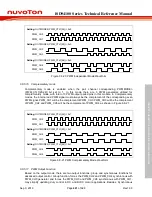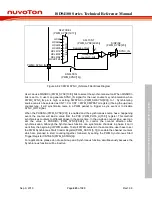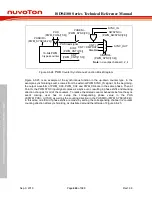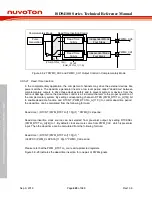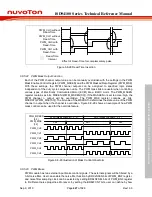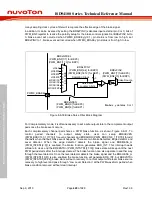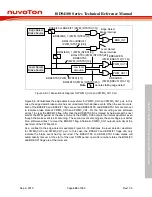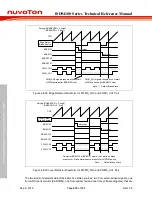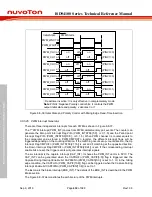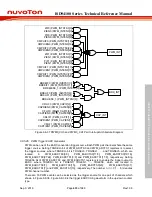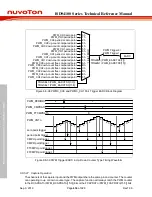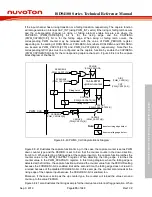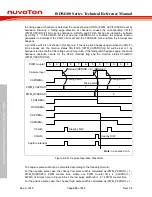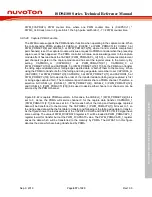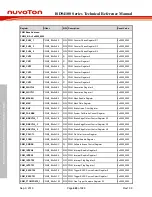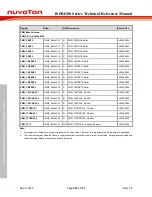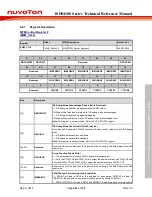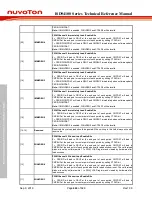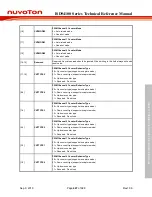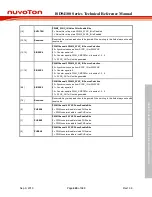
ISD94100 Series Technical Reference Manual
Sep 9, 2019
Page
435
of 928
Rev1.09
IS
D
9
410
0
S
ER
IE
S
T
E
C
HN
ICA
L
RE
F
E
RE
NCE
M
AN
U
AL
if the input channel has a rising transition or a falling transition, respectively. The capture function
will also generate an interrupt CAP_INT (using PWM_INT vector) if the rising or falling latch occurs
and the corresponding channel n’s rising or falling interrupt enable bits are set, where the
CAPRIENn (PWM_CAPIEN[5:0]) bit is for the rising edge and the CAPFIENn
(PWM_CAPIEN[13:8]) bit is for the falling edge. When rising or falling latch occurs, the
corresponding PWM counter may be reloaded with the value of PWM_PERIODn register,
depending on the setting of RCRLDENn or FCRLDENn bits (where RCRLDENn and FCRLDENn
are located at PWM_CAPCTL[21:16] and PWM_CAPCTL[29:24], respectively). Note that the
corresponding GPIO pins must be configured as the capture function by enable the CAPINENn
(PWM_CAPINEN[5:0]) bits for the corresponding capture channel n. Figure 6.8-40 is the capture
block diagram of channel 0.
0
1
16-bits PWM
up/down counter
CNT
(PWM_CNT0[15:0])
DIRF
(PWM_CNT0[16])
PERIOD
(PWM_PERIOD0)
RCAPDAT
(PWM_RCAPDAT0[15:0])
FCAPDAT
(PWM_FCAPDAT0[15:0])
CAPEN0
(PWM_CAPCTL[0])
CAPINV0
(PWM_CAPCTL[8])
CAPINEN0
(PWM_CAPINEN[0])
PWM_CH0
RCRLDEN0
(PWM_CAPCTL[16])
FCRLDEN0
(PWM_CAPCTL[24])
Note:
denotes rising edge detect
denotes falling edge detect
Rising Latch
Falling Latch
Figure 6.8-40 PWM0_CH0 Capture Block Diagram
Figure 6.8-41 illustrates the capture function timing. In this case, the capture counter is set as PWM
down counter type and the PERIOD is set to 8 so that the counter counts in the down direction,
from 8 to 0. When detecting a falling edge at the capture input pin, the capture function latches the
counter value to the PWM_FCAPDATn register. When detecting the rising edge, it latches the
counter value to the PWM_RCAPDATn register. In this timing diagram, when the falling edge is
detected at the first time, the capture function will reload the counter value from the PERIOD setting
because the FCRLDENn bit is enabled. But at the second time, the falling edge does not result in
a reload because of the disabled FCRLDENn bit. In this example, the counter also reloads at the
rising edge of the capture input because the RCRLDENn bit is enabled, too.
Moreover, if the case is setup as the up counter type, the counter will reload the value zero and
count up to the value PERIOD.
Figure 6.8-41 also illustrates the timing example for the interrupt and interrupt flag generation. When

